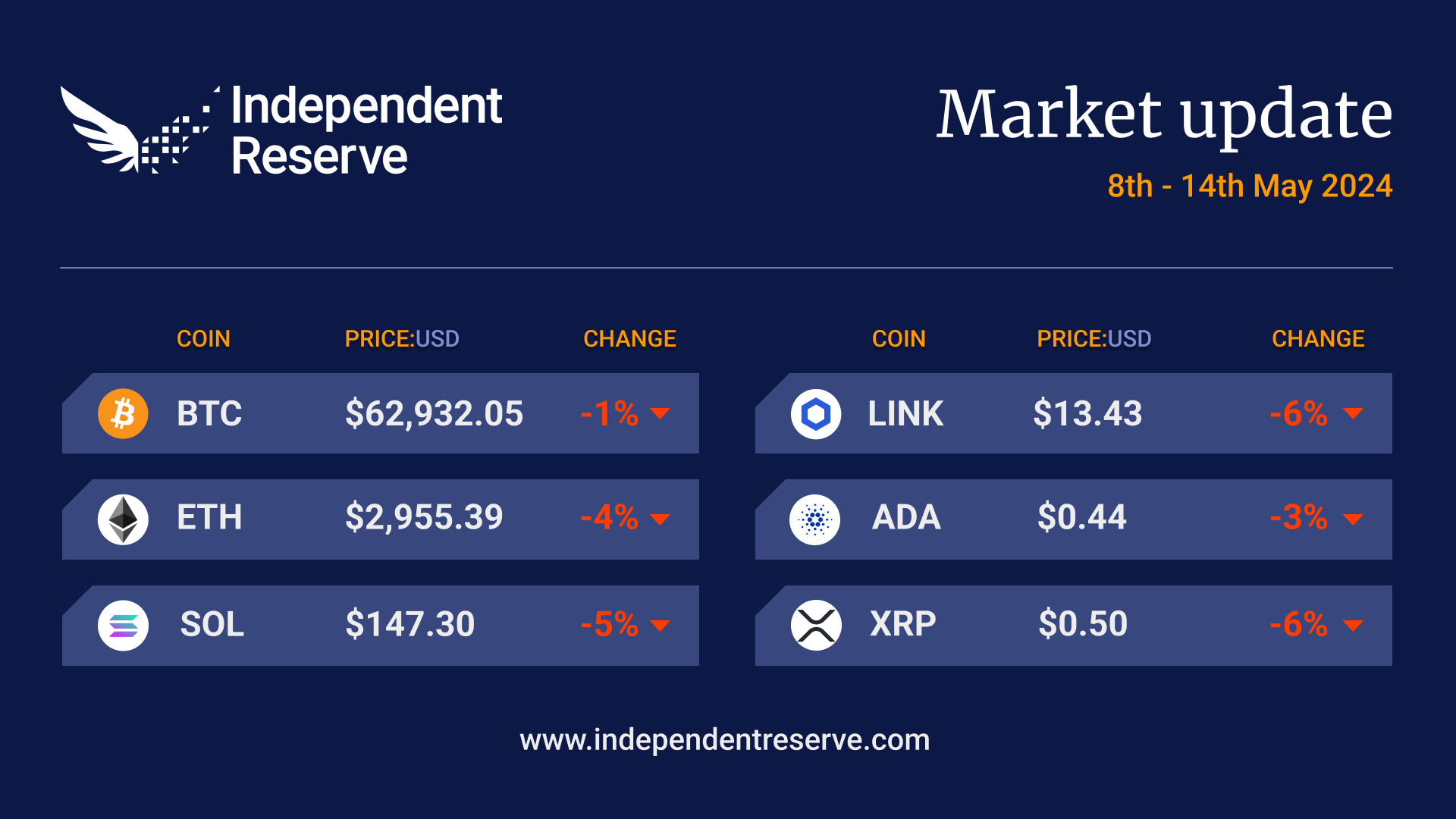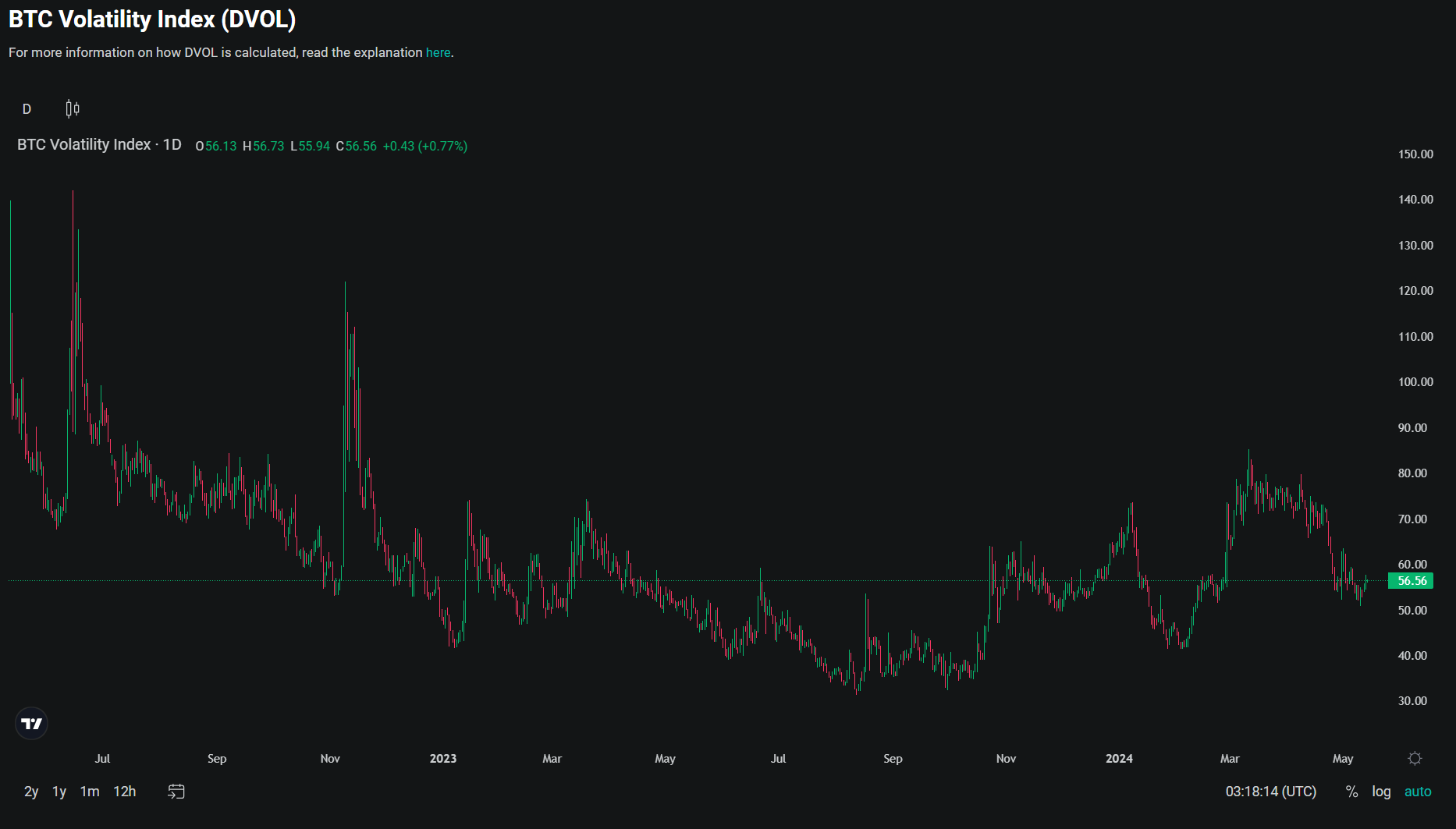In Markets
It was a choppy week for Bitcoin, with the Orange Coin trading between A$97.2K (USD$64K) and A$91.4K (US$60K), with sudden lurches either way. FxPro trader Alex Kuptsikevich warns that Bitcoin could see a panic sell-off if it closes under A$90.8K (the psychological US$60K mark) in the coming days, with traders looking for a break above A$98.3K (US$65K) to signal bullish conditions have returned. All eyes will be on the release of April’s US inflation data this week, with analyst Seth saying “Jerome Powell likely pump our bags” if inflation trends lower. Bitcoin finishes the week down 1.1% to trade around A$94,765 (US$62,752), while Ethereum lost another 4.5% to hit A$4,443 (US$2,942) amid waves of negativity from rivals and expectations of an ETF denial. Solana lost 4.7%, XRP (-7.1%), Dogecoin (-5.6%), Cardano (-4.2%) and Shiba Inu (-3.5%) The Crypto Fear and Greed Index is at 57 or Greed.

From the IR OTC Desk

While this was evident from April to May, option volatility appears to have also stagnated. Until a structural change in either the yield curve term structure or ETF flow develops, tight ranges appear to be the state of play.
One of the clear messages out of the May Federal Open Market Committee (FOMC) meeting, was an ongoing expectation of ‘well anchored’ US consumer inflation expectations. While the backward-looking CPI data remains the primary policy benchmark, forward looking expectations have historically been relatively benign – even in times of near double digit headline inflation. It proves interesting that last week’s Consumer Inflation Expectation release jumped from 3% in March to 3.3% in April. While this is the first upward print in the series since September 2023, this change would have been noted by policy setters and places additional weight on this week’s CPI release. Current market expectation is for Core Inflation (YoY) to move down to 3.6% forecast (April) from 3.8% actual (March).
Economic releases this week include:
In Australia (AEST)
- Wednesday 11:30am AU Wage Price Index (Q1)
- Thursday 11:30am AU Unemployment Rate (April)
In US (AEST)
- Tuesday 10:30pm US PPI (April)
- Wednesday 12:00am US Fed Chair Powell speech
- Wednesday 10:30pm US Inflation data (April)
In Australia, the quarterly Wage Price Index is one of the Reserve Bank’s most critical data inputs and should be tracked closely. Running at the fastest pace since 2008, the Australian Wage Price Index is forecast to track down to 4.1% forecast over Q1, relative to 4.2% actual in Q4 2023. The Reserve Bank of Australia (RBA) as well as the Treasurer’s Office have been dismissive of a potential wage-price spiral developing locally on the back of relatively easy monetary policy settings (compared to global peers). This data will confirm whether this prior assessment is accurate.
On the OTC desk, we continue to see profit-taking. While major flows are relatively balanced, a lack of pricing clarity has created difficult trading markets. This environment can lead to asset holders taking stock of their capital (as well as overtrading!). We have seen the former on the desk this week.
So, what changes the landscape? In the short term, the macro story remains, as well as global cryptocurrency/tax policy developments. Later in the year the US election will become topical and likely create periods of high volatility. Until then, stable coin development and trading has become highly topical and is materially growing in trading volume. This is not Australia specific and is a broad theme for both our Australia and Singapore offices.
For any further information, please feel free to reach out.
In Headlines
Crypto now a US election issue
Crypto suddenly became an issue in the US Presidential elections in November after incumbent Joe Biden and challenger Donald Trump staked out very different positions this week. On Biden’s side, the SEC have introduced a controversial Staff Accounting Bulletin that will restrict Banks’ ability to hold crypto for their customers. A House resolution was raised to kill this SEC guidance, but Biden warned he’ll use his presidential veto to block it if it hits his desk. The motion passed in the House of Representatives anyway, with 21 Democrats joining the Republicans to vote for it. It still has to be approved by the Senate. The following day, Trump came out as pro Crypto, saying SEC boss Gary “Gensler is very much against it … The Democrats are very much against it… If you’re in favour of crypto, you’re gonna vote for Trump because they want to end it.” During his presidency, Trump was no fan of crypto, however.
Polling and crypto voters
“Digital assets have emerged as a significant issue in the upcoming election,” said Blockchain Association CEO Kristin Smith, releasing a poll of 1201 registered voters in US swing states (Michigan, Nevada, Ohio, Montana, Pennsylvania, and Arizona) that found that one in five consider crypto as a significant factor in their vote – although 38% of that group meant they don’t like crypto. Crypto-positive voters are evenly split between the political parties but are more likely to be male, younger, black or Hispanic. Both sides believe that as few as 6% of voters in six swing states could decide the election.
FIT21 heads to a vote
Mostly pro-crypto legislation, known as FIT21, looks like heading for a vote in the US later this month. The bill has been around for a while and would essentially put the Commodity Futures Trading Commission in charge. Crypto Council for Innovation CEO Sheila Warren said, “This is a critical and historic step toward establishing a federal regulatory framework for digital assets in the U.S.” Coinbase has also launched the Stand With Crypto political action committee of 450,000 members to support pro-crypto candidates in the election.
Ether ETF decision in 10 days
The consensus position is that the SEC will not approve an Ethereum ETF by the deadline of May 23, however, there are some faint glimmers of hope. Ark Invest and 21 Shares have removed staking from their amended ETF application, leading to speculation the SEC is engaging with them on the topic. The news saw the odds of approval double on betting markets, but only to a 16% chance. Bloomberg ETF analyst Eric Balchunas, however, said he hadn’t heard of the SEC engaging with applicants and dismissed the move as a “Hail Mary” pass. Grayscale also binned its ETH Futures ETF application, again for unknown reasons. JPMorgan analysts believe the ETF denial is mostly priced in, but it will be approved eventually.
The ATO looks at crypto tax
The Australian Financial Review reports the Australian Tax Office has been asking some local crypto exchanges to provide the data and details of up to 1.2 million accounts. The news is a gentle reminder to traders to accurately report their crypto gains with the end of the financial year coming up. The easiest way to do that is using Independent Reserve’s KPMG Crypto Tax Estimator.
Bitcoin ETFs
The Bitcoin ETFs saw three days of outflows last week, but one very large inflow day more than made up for it and overall, the week saw US$116.8 million (A$176.7M) in new inflows. Notably Grayscale is losing money slower than in any other week since launch. The Hong Kong crypto ETFs looked OK at the end of last week, with US$24.7M (A$37.3M) in new inflows on top of the US$292.7M (A$443M) they were seeded with. But a massive outflow on Monday, left the ETFs with a total of US$20.9M (A$31.6M) in outflows since launch.
Possible reasons to be cheerful
If you ignore the gathering economic storm clouds and focus only on historical trends, then Bitcoin has left the “danger zone” after the halving, according to RektCapital. The analyst says the price action in previous cycles suggests Bitcoin already bottomed at US$56K (A$84.7K) recently, and buyers were reaccumulating. Meanwhile, Swan Bitcoin’s head of business, Dante Cook, says that a US government intervention to prop up the falling Japanese yen (the country is the largest holder of US treasuries) could see a “massive wall of liquidity” injected which is bullish for Bitcoin. Meme stock GameStop doubled in price in a day this week, after Roaring Kitty – the guy who drove the price action last time – returned to social media after three years. The meme stock frenzy coincided with the huge upswing in crypto prices back in 2021. Twitter founder Jack Dorsey told Pirate Wires this week that he believes Bitcoin will hit “at least” US$1 million (A$1.5M) by 2030. “I do think it hits that number and goes beyond,” he said.


